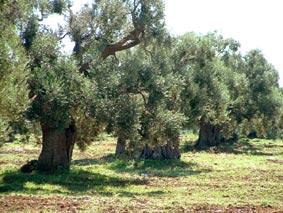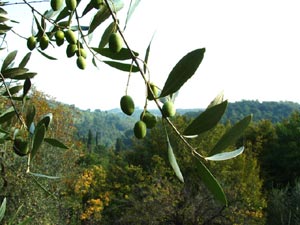|
|
Slow Tuscany
> Tuscany
> Siena
> The Good Giants of Tuscany
Olive
trees:
The "good giants" of Tuscany
Damiano
Andreini
|
|
|
Since
November is about to begin, I need to tell you about another
great Tuscan symbol: the olive. In fact, the period in which
olives are picked and pressed is just now beginning. It is a
ritual that seems to have been repeating itself identically
for thousands of years. The same gestures, the same rhythm of
work, even the machinery in the olive presses are virtually
the same. Participating in a harvest is like going back in time
and becoming an Etruscan, Roman or medieval farmer. We get up
early in the morning because November days are short, and there
is no time to lose. And then its coffee, milk, and jam on your
bread that has been toasted in the fireplace. We dress in wool
so the fog and the cold won't penetrate our bones.
The stairs, the nets, a pair of gloves and we're off! The best
way to pick olives is the simple antique way of taking a hold
of each individual branch and sliding your hand up and down
it until every olive has fallen off onto the net below. The
olive tree is a majestic and robust plant. It's a symbol of
nobility and stability.

According to mythology, the olive tree was created out of a
dispute between the Gods Poseidon and Athena who were competing
for the protectorate of a Greek region. In order to win the
favour of the men, Poseidon donated a beautiful horse to them
as a sign of strength, courage and war. Athena planted her spear
in their land and from it germinated a plant that gushed gold
liquid from its fruit. The Goddess promised all of them that
if they drank the liquid, they would never become violent. The
people chose her gift and called the city Athens. Since then,
the olive has been a symbol of peace, work and serenity.
In Italy, the olive appeared in about 600 B.C. It was brought
by sea from Greek colonies and was first cultivated by the Etruscans.
Adult olive plants are tall and large enough so that at least
three or four people are needed to work on them at a time. This
is when different personalities will emerge: who will be on
the ground to pick and who will be adventurous enough to climb
to the very top of the tree.
From the top of an olive tree at the peak of a hill, the world
is not the same. The sky is cloudy. The fog in the background
is disturbing and the dark and dangerous forests of autumn furnish
gloomy and suggestive scenes in which it's a pleasure to lose
oneself among the repetitive movements of the harvest. On beautiful
days those forests and valleys come back to life with the warm
colours touched by golden rays of sunlight. In either case,
you will never feel like coming back down. In Tuscany, and in
Italy in general, there are olive trees as old as Romanesque
Cathedrals and, sometimes, even more beautiful. It is a fact
that an olive tree can live for over 1,000 years. Broad, dark
trunks that are contorted and hollowed out from centuries of
rainfall often seem like strange animal shapes. The tallest
branches, dry and curved, resemble thin, shaking arms. But it
isn't easy to find them.
In 1985, Tuscany was hit by an exceptional cold spell and many
of the trees, even the oldest ones, did not survive the snow
and ice and had to be replaced. Yet it seems incredible that
the majority of the surviving "good giants" are found not just
in Tuscany, but near antique monastery complexes. Is it the
meticulous care of the monks or Divine favour? Whatever it may
be, try to visit the Benedictine Abbey of Sant' Antimo, or the
one near Mt. Oliveto Maggiore, or the ones of the Carthusian
Monks of Calci and of Florence. The list could go on and on.
Along with its bricks, statues, and enormous frescos on the
walls, each one of these incredible architectural complexes
has preserved its precious olive trees for centuries as well.
As you can see, I haven't talked to you yet about olive oil,
and there is a reason. On-line you can look up a site that was
created by a Tuscan farmer who seems to be not only an expert
on good olive oil, but also a true believer in the traditional
Tuscan farmer. On the site you'll find sections on the cultivation,
harvesting, and pressing of olives as well as pictures of Gino
and Pina, experts in pruning and harvesting olives. Before saying
"goodbye", I want to remind you about another
site that will tell you about the health benefits
of an olive-oil based diet.
Damiano Andreini |
|
|
